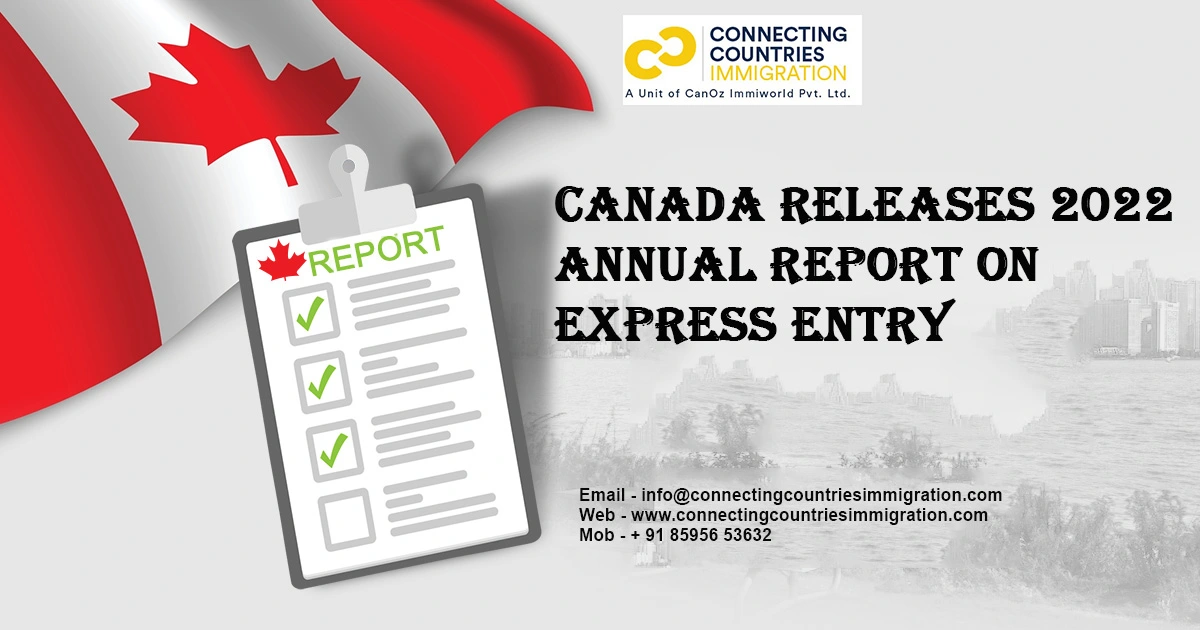Every year, Immigration, Refugees, and Citizenship Canada (IRCC) publishes an Canada Releases 2022 annual report on Express Entry, with the 2022 version being the most recent.
The name of the application management system utilized by the federal government of Canada to attract foreign skilled workers seeking permanent residency (PR) is Express Entry.
The Express Entry system, which was launched in 2015, consists of three key programs: the Canadian Experience Class (CEC), the Federal Skilled Worker Program (FSWP), and the Federal Skilled Trades Program (FSTP).
It’s also worth mentioning that this system manages a portion of the Provincial Nominee Program (PNP), albeit PNP candidates must also be eligible for at least one of the three categories mentioned above in order to enter Canada through Express Entry.
Please keep in mind that the data in this post is from January to December 2022.
The number of Express Entry profiles filed in 2022 is slightly lower than in 2021.
In 2022, 428,391 Express Entry profiles from all programs were submitted. This indicates a 3% decline from 2021 but a 19% increase from 2020. In 2021, at least 74% of the profiles submitted were qualified for at least one of the Express Entry-managed immigration programs.
Men (238,382) submitted more profiles than women (189,881). Men (56%) and women (44%) submitted the same proportion of total profile submissions as in 2021. While men’s (71% of profile submissions) eligibility for at least one program did not change from 2020 to 2022, women (78%) saw a minor increase over previous years in 2022.
The majority of Express Entry profile applications are produced by people with CRS scores ranging from 301 to 500.
CRS scores are used to rank Express Entry candidates based on selection factors such as age, language ability, education, work experience, and others. The report mentions that the “Express Entry pool is dynamic, and the distribution of CRS scores changes” with each new qualifying profile submission.
Despite a minor decline in the overall number of eligible profiles submitted in 2022, CRS scores for eligible candidate profiles at the time of submission remain continuously concentrated in the 301-500 range.
Additional CRS points can be awarded if a candidate was educated in Canada, speaks French fluently, or has Canadian siblings. The majority (55%) of those who submitted profiles in 2022 did not match the criterion for any further points. However, there has been a gradual decrease since 2020 (63%) and 2021 (58%), indicating that a growing proportion of candidates are eligible for at least one type of bonus point. Candidates who satisfied the criteria for education in Canada (23%) and having siblings in Canada (14%), performed the best.
Who was given the opportunity to apply for permanent residence through Express Entry?
ITAs issued by draw in 2022
In 2022, the IRCC conducted 24 Express Entry lotteries and granted 46,539 invitations to apply (ITAs), a 59% decline from the 114,431 invitations issued in 2021. This reflects the IRCC’s decision to temporarily halt ITAs to the Federal High Skilled Immigration Programs operated by Express Entry, with only PNP-specific rounds continuing from September 2021 to July 2022.
Furthermore, due to short general round invitation pauses, the bulk of ITAs were awarded to candidates under two programs in 2022: 19,258 via PNPs and 18,895 under CEC.
In 2022, the remaining 8,386 ITAs were issued to candidates through the FSWP, and no ITAs were provided through the FSTP.
ITAs issued by gender in 2022
Men received 58% of the Express Entry invitations granted in 2022, which is identical to the proportion of eligible profile submissions submitted by men as a proportion of overall profile submissions. Men received more invitations than women in both the CEC (42% vs. 39%, respectively) and the PNP (43% vs. 39%, respectively).
This contrasts with 2021, when a greater number and proportion of invitations were issued to men and women under the CEC.
ITAs issued by age in 2022
In terms of the age of candidates invited to apply, individuals aged 20-29 received 50% of the invitations given in 2022. The CRS assigns the most points to this age group. Those aged 30-34 were the second largest age group and saw the greatest proportional growth in 2022 (29%) from 2021 (19%).
ITAs issued by education level in 2022
In general, the amount of ITAs awarded to Express Entry applicants in 2022 increased in accordance with an individual’s greatest degree of education. Only 1% of ITAs (540) were awarded to applicants with a high school diploma or less this year. Applicants with a one- or two-year post-secondary credential received 9% of all ITAs, while those with a three-year or longer program received 40% of all ITAs. Those with a master’s degree or entry-to-practice professional degree certificate received nearly half of all 2022 ITAs (46%). Finally, PhD holders constituted up 4% of all ITA recipients last year.
ITAs issued by language proficiency in 2022
In general, those with higher first official language proficiency received more ITAs in 2022, according to their Canadian Language Benchmark (CLB)/Niveaux de compétence linguistique canadien (NCLC) score.
The number of ITAs awarded to applicants at each CLB/NCLC level in 2022 is listed below in order of score:
· CLB/NCLC 4: 7 ITAs issued
· CLB/NCLC 5: 817 ITAs issued
· CLB/NCLC 6: 2,094 ITAs issued
· CLB/NCLC 7: 9,444 ITAs issued
· CLB/NCLC 8: 8,709 ITAs issued
· CLB/NCLC 9: 15,587 ITAs issued
· CLB/NCLC 10: 9,881 ITAs issued
ITAs issued by years of Canadian work experience in 2022
According to data from this report, the majority of ITA recipients this year had one year of Canadian work experience. Indeed, 41% of all ITA recipients (18,986) had at least one year of work experience in Canada. The second highest proportion of ITA recipients (16,066 ITAs, or 35% of all ITAs) had no prior Canadian employment experience. The only other group that obtained more than 4% of ITAs were Express Entry candidates with two years of Canadian work experience, who received 7,246 ITAs (16%).
In 2022, candidates having the following amount of Canadian work experience obtained four percent or less of all Express Entry ITAs.
· Less than one year (1,957 ITAs, 4%)
· 3 years (1,528 ITAs, 3%)
· 4 years (480 ITAs, 1%)
· 5 years (276 ITAs, less than 1%)
ITAs issued by years of international/foreign work experience in 2022
Foreign job experience among 2022 ITA winners revealed an intriguing trend, comparable to Canadian work experience, in that ITAs did not simply increase with more years of work experience overseas. In fact, while applicants with 5 or more years of overseas work experience received the largest proportion of ITAs (35%) (16,251), those with one year or less experience received the second highest proportion (12,569 ITAs, 27%).
The following is a list of the remaining ITAs issued based on candidates’ years of foreign work experience:
· 1 year: 3,796 ITAs (8%)
· 2 years: 3,267 ITAs (7%)
· 3 years (6,035 (13%)
· 4 years (4,621 (10%)
ITAs given in 2022 as a result of additional points assigned and criterion met for additional points
The report included information on invitations sent to men and women who met the requirements for each additional point kind. In 2022, the most prevalent additional point kinds for which both men and women satisfied qualification were Education in Canada (19,587 ITAs) and Arranged Employment (8,756 ITAs).
In 2022, the most popular bonus point type for men was Education in Canada and Arranged Employment, while the most common for women was Education in Canada and French language proficiency.
Over the last three years, the share of additional points for Arranged Employment for both genders has been consistent, with males achieving the criterion at a higher proportion (65%) than women (35%). While both genders received the same amount of ITAs in 2020 and 2021, both at 50%, women met the criteria for French-language proficiency points in a slightly larger proportion than men, at 53% vs 47% in 2022.
The technology industry had the top three primary jobs among 2022 ITA recipients.
The most prevalent primary vocations among individuals invited to apply for permanent residency through Express Entry in 2022 have changed significantly from prior years.
In 2021, invitations were shifted to CEC and PNP-specific rounds. This resulted in a significantly higher number of candidates with TEER 2 occupations (i.e., occupations that usually require a college diploma, including occupations that require 2 or more years of apprenticeship training, or supervisory occupations). Candidates with TEER 1 vocations (often requiring a university degree) made up a sizable part of ITAs in 2022.
The most frequent vocations in 2022 were those primarily related to technology. Software engineers and designers, information systems professionals, and computer systems developers and programmers were the most prevalent jobs, accounting for a sizable share of the individuals asked to apply through Express Entry in 2022.
Furthermore, food service directors and chefs were the most popular vocations among individuals invited to apply in 2022.
In 2022, software engineers and designers were given the most Arranged Employment points for Express Entry.
In both 2020 and 2021, the most prevalent occupation among individuals invited to apply who were assigned Arranged Employment points was food service supervisors, but in 2022, it was software engineers and designers.
For the second year in a row, the majority of ITA grantees were Canadians, Indians, and Nigerians.
This year, the majority of immigration candidates who acquired an ITA through the Express Entry system were Canadian citizens (31,486). This follows a recent trend in which Canada was the leading country of residence among ITA recipients in 2021 (102,906) and 2020 (68,061). The majority of international Express Entry applicants that received an ITA were from India (3,787) or Nigeria (1,730). These two countries were also in the top three a year ago.
The following is a full list of the top ten countries of residence among 2022 ITA recipients (the number of ITAs awarded to inhabitants of each nation is in parentheses).
Canada (31,486) is ranked first.
2. India (3,787)
Nigeria (1,730).
Cameroon (1 063)
5th (842): United States of America
Morocco (793).
United Arab Emirates (783).
Lebanon (559).
Algeria (550).
France (381st)
The majority of ITA grantees were Indian citizens, with Algeria and China close behind.
According to additional data, the top countries of citizenship among ITA recipients have also shifted slightly over time. India has topped the rankings for the last three years in a row. The People’s Republic of China ranked second on this list in 2020 and 2021. Finally, although Nigerian nationals obtained the third most ITAs in 2020 (6,550), citizens of the Republic of Korea received the third most (3,131) in 2021.
In the same vein as the preceding data, the following is a complete list of the top ten countries of citizenship among ITA recipients in 2022. The number of ITAs issued to inhabitants of each country is listed in parentheses next to their name.
1. India (20,769)
Algeria is ranked second (2,909).
2. Chinese People’s Republic (2,456)
Cameroon (4,218)
5. Iran (1,210)
France (1 069)
Morocco (7978)
939. United States of America
9th (934) Philippines
Pakistan (923).
The majority of ITA recipients settle in Ontario, British Columbia, and Alberta.
Given the historical history of Canadian permanent residents settling primarily in three provinces – Ontario, Quebec, and British Columbia – it is worthwhile to examine the province of destination among 2022 Express Entry applicants.
Following in the footsteps of previous years, the majority of Express Entry candidates (16,978) landed in Ontario in 2022. Notably, the proportion of candidates who settled in this province has decreased from 61% in 2021 to 48% this year. The next two most popular provinces of destination, British Columbia (6,966) and Alberta (4,372), accounted for 20% and 12% of all Express Entry applicants, respectively.
Following in the footsteps of the previous two years, Canada’s three territories – Nunavut, the Northwest Territories, and Yukon – were the country’s least popular Express Entry applicant locations (78 total people in 2022).
Note that Quebec-bound Express Entry applicants are not included in this data because the province has its own immigration systems.
Express Entry application processing times generally slower than 2021
For the second year in a row, most Express Entry candidates’ application processing times have increased. The total processing time for applications from all programs (21 months) increased from 8 months in 2021 to 21 months in 2022. Notably, this is mostly due to the average processing time for FSTP applications rising from 23 months in 2021 to 63 months in 2022, defined as the number of months it takes IRCC to finalize 80% of applications. By program, 80% of CEC applications were processed in 19 months (up from 6 months in 2021), FSWP applications in 29 months (up from 28 in 2021), and PNP applications in 13 months*.
*PNP applications took 21 months to process, on average, in 2021
Conclusion
The Express Entry application management system, now in its seventh year of operation, has proven to be a reliable source of immigration for Canada’s federal government as well as a popular immigration pathway to Canada for foreign nationals from around the world. Thousands more highly skilled foreign nationals were granted permanent residency in the United States under the Express Entry system’s three programs.
Despite the fact that the number of ITAs issued in 2022 fell by 59% from the previous year, IRCC continued to welcome skilled economic immigrants to Canada who should be able to adapt well to the country and contribute to its economic and social success.
Looking ahead, the Express Entry system has already been enhanced to better target some of the areas of Canada’s labour market with the greatest job gaps and needs. This was accomplished through the IRCC’s category-based Express Entry drawings, which began on June 28, 2023. These draws primarily target immigrants with French language or recent work experience in the five occupational groups listed below: healthcare, science, technology, engineering, and mathematics (STEM), transportation, trades, and agriculture/agri-food. Category-based draws have been and will continue to be an important component of Canada’s progress toward addressing the country’s most pressing labour market concerns.
As of the time of this writing, the IRCC had already granted 11,900 ITAs to immigration candidates in these targeted categories for 2023.
Canada’s immigration department will continue to look for ways that the application management system can be used more effectively and profoundly to ensure that Canada can benefit from the global skilled worker community while remaining one of the world’s best immigration destinations.



